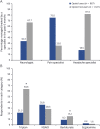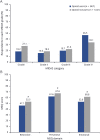Characterizing opioid use in a US population with migraine: Results from the CaMEO study
- PMID: 32527971
- PMCID: PMC7455347
- DOI: 10.1212/WNL.0000000000009324
Characterizing opioid use in a US population with migraine: Results from the CaMEO study
Abstract
Objective: To determine the prevalence of and risk factors associated with opioid use in the treatment of migraine, we examined demographics and clinical characteristics of 867 individuals who reported using opioids for the treatment of migraine.
Methods: We analyzed data from the CaMEO study (Chronic Migraine Epidemiology and Outcomes), a cross-sectional, longitudinal, Internet study, to compare sociodemographics, clinical characteristics, and migraine burden/disability of opioid users vs nonusers. Covariates were entered as categorical or continuous variables. Factors associated with opioid use were identified using nested, multivariable binary logistic regression models.
Results: Of 2,388 respondents with migraine using prescription medications for acute treatment, 36.3% reported that they currently used or kept on hand opioid medications to treat headaches. Current opioid users had significantly more comorbidities, greater headache-related burden, and poorer quality of life than nonusers. Regression models revealed factors significantly associated with opioid use, including male sex, body mass index, allodynia, increasing monthly headache frequency, Total Pain Index score (excluding head, face, neck/shoulder), anxiety, depression, ≥1 cardiovascular comorbidity, and emergency department/urgent care use for headache in the past 6 months. Self-reported physician-diagnosed migraine/chronic migraine was associated with significantly decreased likelihood of opioid use.
Conclusions: Of respondents who were using acute prescription medications for migraine, more than one-third used or kept opioids on hand, contrary to guidance. This analysis could not distinguish risk factors from consequences of opioid use; thus further research is needed to guide the development of strategies for reducing the inappropriate use of opioids in migraine.
Copyright © 2020 The Author(s). Published by Wolters Kluwer Health, Inc. on behalf of the American Academy of Neurology.
Figures



Comment in
-
Reader Response: Characterizing Opioid Use in a US Population With Migraine: Results From the CaMEO Study.Neurology. 2021 Apr 6;96(14):683. doi: 10.1212/WNL.0000000000011708. Neurology. 2021. PMID: 33820840 No abstract available.
-
Author Response: Characterizing Opioid Use in a US Population With Migraine: Results From the CaMEO Study.Neurology. 2021 Apr 6;96(14):683-684. doi: 10.1212/WNL.0000000000011718. Neurology. 2021. PMID: 33820841 No abstract available.
-
Reader Response: Characterizing Opioid Use in a US Population With Migraine: Results From the CaMEO Study.Neurology. 2021 Apr 6;96(14):684. doi: 10.1212/WNL.0000000000011721. Neurology. 2021. PMID: 33820842 No abstract available.
-
Author Response: Characterizing Opioid Use in a US Population With Migraine: Results From the CaMEO Study.Neurology. 2021 Apr 6;96(14):684-685. doi: 10.1212/WNL.0000000000011722. Neurology. 2021. PMID: 33820843 No abstract available.
-
Reader Response: Characterizing Opioid Use in a US Population With Migraine: Results From the CaMEO Study.Neurology. 2021 Apr 6;96(14):685. doi: 10.1212/WNL.0000000000011723. Neurology. 2021. PMID: 33820844 No abstract available.
-
Author Response: Characterizing Opioid Use in a US Population With Migraine: Results From the CaMEO Study.Neurology. 2021 Apr 6;96(14):686. doi: 10.1212/WNL.0000000000011724. Neurology. 2021. PMID: 33820845 No abstract available.
References
-
- Headache Classification Committee of the International Headache Society. The International Classification of Headache Disorders, 3rd edition. Cephalalgia 2018;38:1–211. - PubMed
-
- Pietrobon D, Moskowitz MA. Pathophysiology of migraine. Annu Rev Physiol 2013;75:365–391. - PubMed
-
- GBD 2016 Disease and Injury Incidence and Prevalence Collaborators. Global, regional, and national incidence, prevalence, and years lived with disability for 328 diseases and injuries for 195 countries, 1990-2016: a systematic analysis for the Global Burden of Disease Study 2016. Lancet 2017;390:1211–1259. - PMC - PubMed
-
- Lipton RB, Bigal ME, Diamond M, Freitag F, Reed ML, Stewart WF. Migraine prevalence, disease burden, and the need for preventive therapy. Neurology 2007;68:343–349. - PubMed
-
- Lipton RB, Bigal ME, Scher AI, Stewart WF. The global burden of migraine. J Headache Pain 2003;4:S3–S11.
Publication types
MeSH terms
Substances
LinkOut - more resources
Full Text Sources
Medical
Miscellaneous
